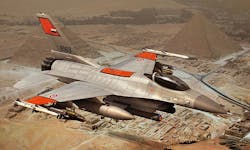Lockheed Martin to upgrade airborne electronic warfare systems aboard Egyptian F-16 jet fighters
Officials of the U.S. Air Force Life Cycle Management Center at Wright-Patterson Air Force Base, Ohio, are asking the Lockheed Martin Aeronautics segment in Fort Worth, Texas, to install EW equipment on Egyptian -16C/D Block 52 aircraft.
Lockheed Martin will install 20 Raytheon Advanced Countermeasure Electronics System-System Integrity (ACES SI) retrofit kits, modify 24 radar warning receivers, and procure three electronic warfare memory loader verifiers for the Egyptian combat jets.
The Raytheon ACES is an integrated EW suite with situational awareness and jamming capabilities. ACES represents a modern EW digital technology that forms an electronic shield against anti-aircraft missiles and threats from enemy radars, Raytheon officials say.
Related: Exelis to provide EW jammer pods to Turkish air force F-16 jets in $75.3 million contract
Designed to detect, identify, and counter incoming enemy missiles in crowded airspace, ACES integrates The Raytheon ALQ-187(V)2 jammer, the ALR-93 radar warning receiver, and the ALE-47 countermeasures dispenser system that enable the F-16 to protect itself from enemy missiles.
The ACES system comes from the newly formed Electronic Warfare Systems mission area of the Raytheon Space and Airborne Systems business unit in El Segundo, Calif.
On this contract Lockheed Martin will do the work in Fort Worth, Texas, and should be finished by October 2015.
For more information contact Lockheed Martin Aeronautics online at www.lockheedmartin.com/us/aeronautics,, Raytheon Space and Airborne Systems at www.raytheon.com, or the Air Force Life Cycle Management Center at www.wpafb.af.mil/aflcmc.
